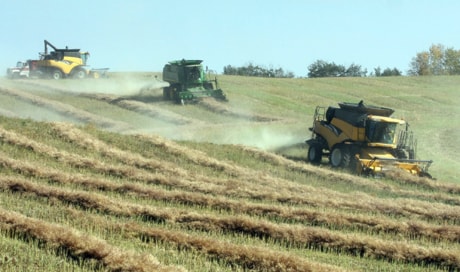REGINA — A dismal summer that was often cool and overcast could have left Prairie farmers looking at near-empty bins, but instead many are reaping bumper crops thanks to an abnormally warm September.
“Most of the summer it kind of looked pretty iffy,” said Ian Wishart, president of Keystone Agricultural Producers, which represents farmers in Manitoba.
“We wondered quite frankly through to the end of August if a lot of the stuff was going to make it.”
The warm weather was “literally worth millions to western Canadian farmers,” he suggested.
“With the great September we had, it was a better-than-average crop for a lot of guys. Nobody really in the business thought that this was going to turn out to be a better-than-average year.”
Predictions early in the growing season were dire.
Some farmers were able to get seeding done at the end of April or in early May as usual, but crop development was behind schedule, said Humphrey Banack, president of the Wild Rose Agriculture Producers.
“There were some real very strong concerns that the crop may not come off at all or if it did, it would be a lower quality, lower yielding crop,” said Banack, who grows grain and oilseeds near Camrose, Alta.
In its early crop forecast released in June, the Canadian Wheat Board said cold weather across the Prairies during the spring had delayed planting and slowed growth. The board said that “without ideal growing conditions for the remainder of the crop year, below-average production is likely for Western Canada.”
It was all farmers in Alberta, Saskatchewan and Manitoba could do to hope that things would turn around.
They got their wish in September.
Parts of the Prairies baked in the warmest September ever. Heat records fell daily in Alberta and Saskatchewan. In Edmonton, temperatures hit 33.6 C on Sept. 23 — the first full day of autumn. That same day in Regina the mercury climbed to 30 C.
Environment Canada says the normal average daily temperature in Winnipeg in September is 12.3 C — this year it was about 18 C.
“We had the September that we were hoping for and it made a huge difference,” said Wishart, who grows cereals and canola near Portage la Prairie, Man.
“It pushed a lot of the crops through to maturity in record time it seems. Canola that was cut one week fairly green ... in 10 days was ready to go with the wonderful drying conditions we had.”
In its most recent crop report, Saskatchewan Agriculture credited excellent weather from Sept. 22 to 28 with allowing producers to push closer to completing their harvest.
Among them was Brian Andrew, who grows canola, peas, lentils, barley and wheat on his farm in Craven near Regina.
He said his harvest was 10 to 14 days behind schedule because crops were staying greener longer than normal, but the unseasonably warm September “got us caught up.”
“It felt like we were combining in August in the middle of September,” said Andrew. “It just was very odd but we weren’t complaining that’s for sure.
“A lot of people got a significant amount ... in the bin with that heat. If we hadn’t had it — if we’d had a normal September, if there is such a thing — I think there would have been a lot of quality and harvest issues.”
Instead, he said, the frost stayed away and now he’s got a top-grade crop.
In a report last week, Statistics Canada said that Prairie farmers overall still reported decreases in all major grains over last year with the exception of spring wheat in Manitoba. But the report also said the harvest was well under way and yields for most crops were higher than those expected in a preliminary survey taken at the end of July.
Banack, whose family has farmed the same land for a century, said the warm, dry weather across most of Alberta in September was “a real boon” to finishing up the harvest.
“It really sped the harvest up and I think a lot of producers are probably in the 85 per cent harvest done rather than the pickle we could have been if we’d had a normal September.”
